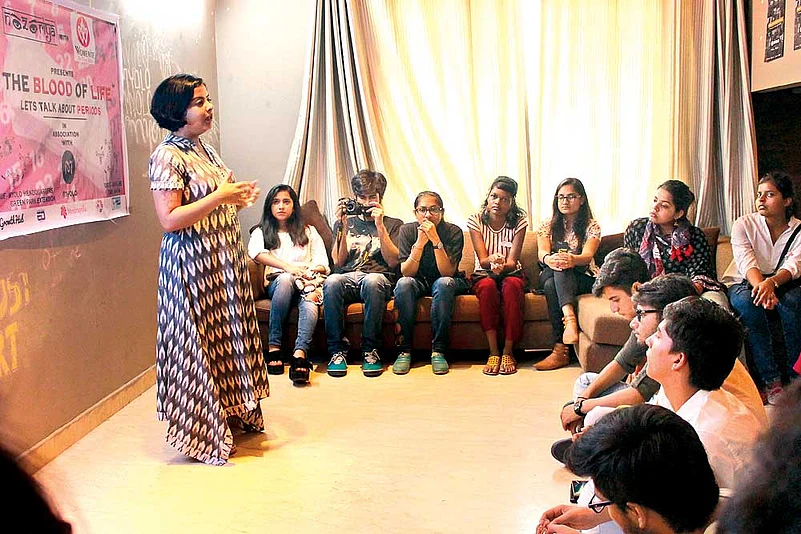Rituja Deshpanday recently chose to make quite a surprise change to her routine around what comes as a monthly ritual lasting five-odd days: she switched from sanitary napkins to cloth pads. The factory-made absorbent had been integral to the Delhiite’s personal hygiene since adolescence, but today the thirtysomething is dismissive of the notion that folded cotton fabric isn’t an advisable option during periods. Far from that, Rituja now avers that using cloth isn’t bad at all. “Yeah, it’s almost a radical step for someone who has always used disposables,” she shrugs. “I used those napkINS because we grew up believing they are the only method for sanitation.”
Apparently, a growing set of women in urban India no longer believe so—and are looking for alternatives. Quite a few among them have become more open to different kinds of reusables: loose cloth, cloth pads, menstrual cups. While clean habits still remain the fundamental principle, this change in mindset is driven by a growing green consciousness.
This trend of moving away from sanitary pads is shaping up as a movement, partly buoyed by parallel efforts to spread public awareness around alternative forms of sanitation. For instance, the workshops run by Delhi-based entrepreneur Priyanka Jain, besides a clutch of YouTube channels, to sensitise women on the subject, while also throwing light on pertinent ecological issues. “Sanitary waste accounts for about 3 per cent of all waste in our country. The pads are not being disposed of as biochemical waste as they should ideally be,” she says.
If urban women have now begun to shun disposables in however small numbers, rural areas are largely on the older, reverse trend still—outside the loop but being brought in. Soon women there will confront the conflicting messaging: the glossy ads of the modern type versus the benefits, now being cited, of the traditional methods of managing menstruation. Which side will win? The picture right now is complicated.
While companies tout the benefits of napkins—which have a global history of a few dozen decades, with the first commercially manufactured sanitary pads launched in the US in the last leg of the 19th century—experts say the ‘sanitary pad revolution’ may have already come and gone in the country. Disposables were largely seen as aiding the kind of mobility that modern life demands of women, with many joining the formal workforce—unlike the old days where social seclusion was taken for granted. But many women are coming around to the view that traditional forms of menstrual care far exceed disposables in comfort as well as hygiene.
Official data shows almost a half of India’s rural women and more than three-fourths of their urban counterparts use sanitary pads. The government’s 2015-16 National Family Health survey pegs their percentage figures at 48.55 and 77.5 respectively. It rubbishes a study which concluded that only 12 per cent of Indian women use sanitary pads while others rely on methods such as cloth, leaves and at times even ash. For, this survey—its figure is often quoted in write-ups—conducted by AC Nielsen and Plan India used a minuscule sample size of 1,033 women, which least reflects the situation on ground.
It was as an improvement over ‘unhealthy’ traditional methods of sanitation that napkins, primarily of foreign make, were introduced in rural and urban India in the last century. And that naturally brought in a narrative about pads being safer. Take the Bill and Melinda Gates Foundation. The Seattle-based private venture has invested close to $3 million over the past few years in a variety of projects related to the development of a reusable and self-decontaminating sanitary pad in developing nations. UNICEF too pushes the idea of using sanitary pads as a much preferred option for women under the world body’s programme called WASH (water, sanitation, hygiene).
The biggest push, though, comes from the usual suspect: the napkin-producing multinationals that control more than two-thirds of the India’s sanitary pad market. Sinu Joseph, who is the managing trustee of Mythri Speaks Trust that works with menstrual health in the country, says such manufacturers use ‘advocacy groups’ as fronts for sanitary napkin promotion. “There is an obvious foreign push to penetrate the Indian market because a majority of the manufacturers are foreign companies,” she says. “While this is the case, the front is usually a charitable entity, especially when it comes to rural India.”
What’s more, foreign funding usually goes to NGOs in the hope that more awareness of sanitary pads would eventually help such companies penetrate the rural market, according to Joseph. She recalls how four MNCs had approached her as well to promote sanitary napkins in rural India—an offer Mythri Speaks refused. “Most other NGOs working on menstrual hygiene in India have grabbed the opportunity,” she adds. “It’s an irony that these organisations are trying to earn a living in the name of promoting menstrual hygiene, and are themselves being taken for a ride by big corporates through global grants.”

Manufacturing standards of sanitary pads too remain suspect in India, where companies haven’t updated formulae since the 1980s. Such products can fly under the radar on several parameters, such as pH balance (in the context of the capacity of the napkin to impact cells and tissues of the human body) and allied safety concerns. Experts say they have been told by manufacturers themselves that popular brands have a different quality for India and poorer nations, compared to the developed ones. Indian consumers are believed to be price-conscious, prompting large manufacturers to cut down on the quality.
Rural women, according to Joseph who has interacted with women through the country about the subject, are “well aware” of sanitary pads. The oft-cited argument that napkins are unaffordable also does not hold true: the cheapest variety costs only Rs 22 for eight pads. Experts in the field say that it’s because they prefer cloth pads that most women in India’s villages don’t buy napkins. “For instance, tribal women in interior areas refuse to use disposables since they’re particular about not littering their villages,” adds Joseph.
Priyanka’s organisation is working on a campaign named Green The Red that uses volunteers across India to promote environment-friendly options for sanitation. Her portal, Hygiene And You, sells such products. Have their sales gone up over time? “Well, I’ve noticed a shift towards alternate methods in the past couple of years,” she says. “Women were initially reluctant to go back to traditional options since they were conditioned to believe that not only are pads more hygienic but that they are a status symbol of sorts. After consistently telling them about the benefits and doing away with myths about cloth napkins, many have begun adopting traditional methods.”
Many other organisations too have taken to manufacturing more eco-friendly options. For instance, Saathi pads are manufactured using banana fibres locally sourced from Gujarat. There are other endeavours to sell cloth pads that resemble disposables in shape and size and come in attractive packaging.
If cloth had been thought to be unhygienic, it is also because of a taboo: tradition does not allow or encourage women to dry their menstruation cloth in the sun or wash it with other clothes. Now, as women both urban as well as educated are moving—in whatever measures—to adopt traditional sanitary methods during menstruation, many hope more light would fall on the subject sooner rather than later.


























